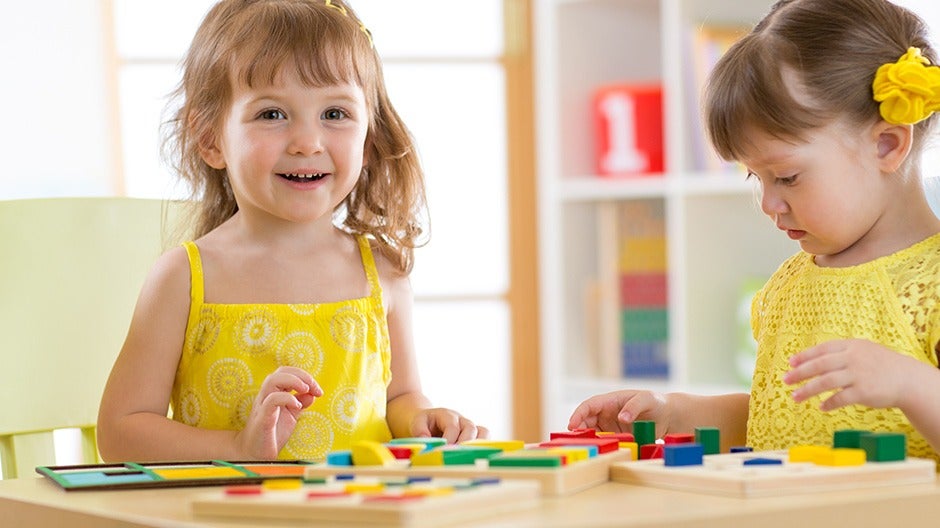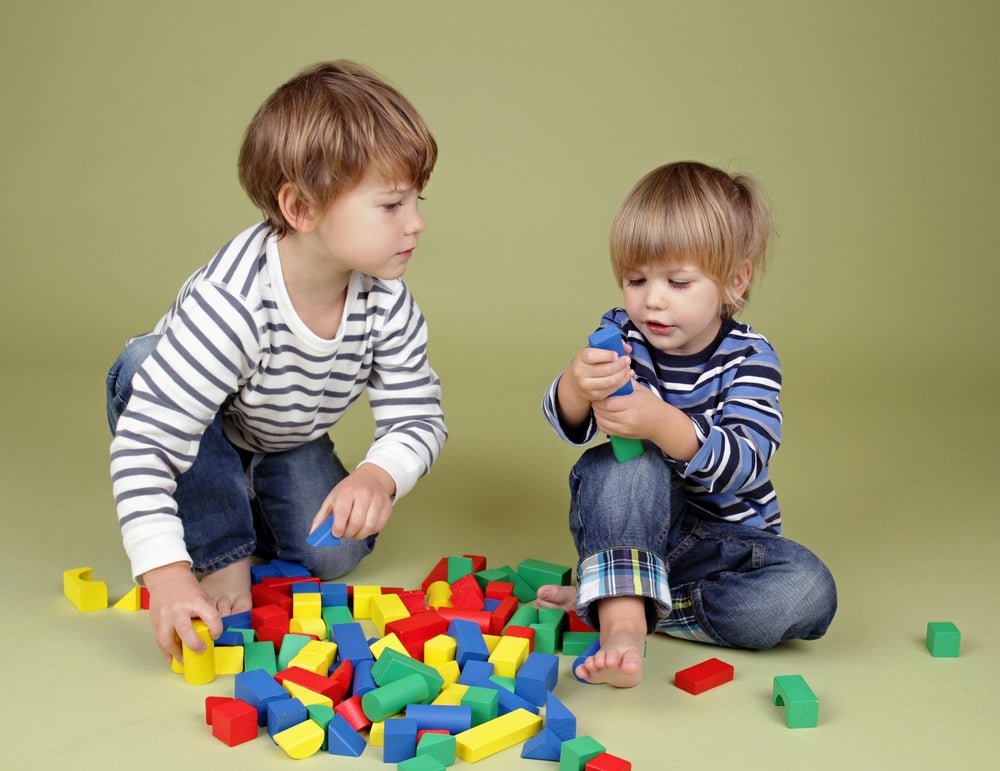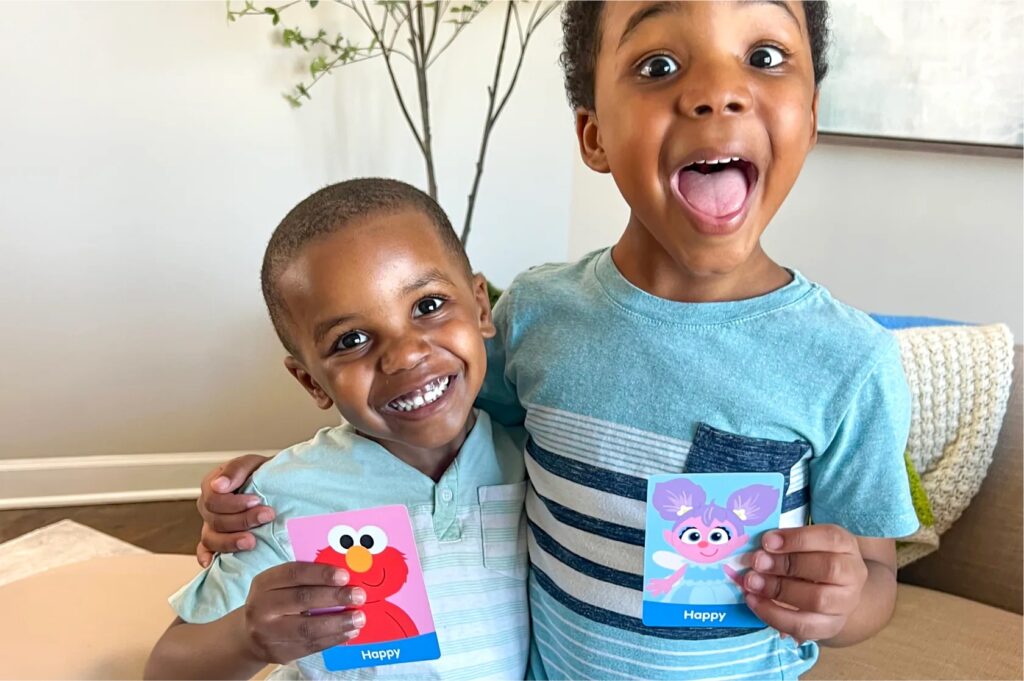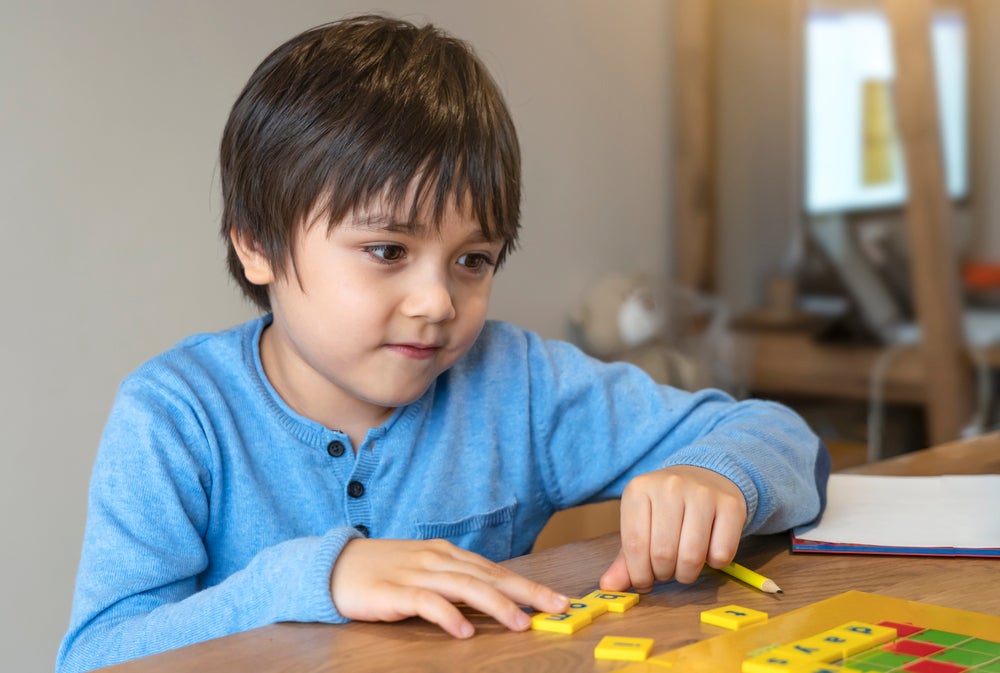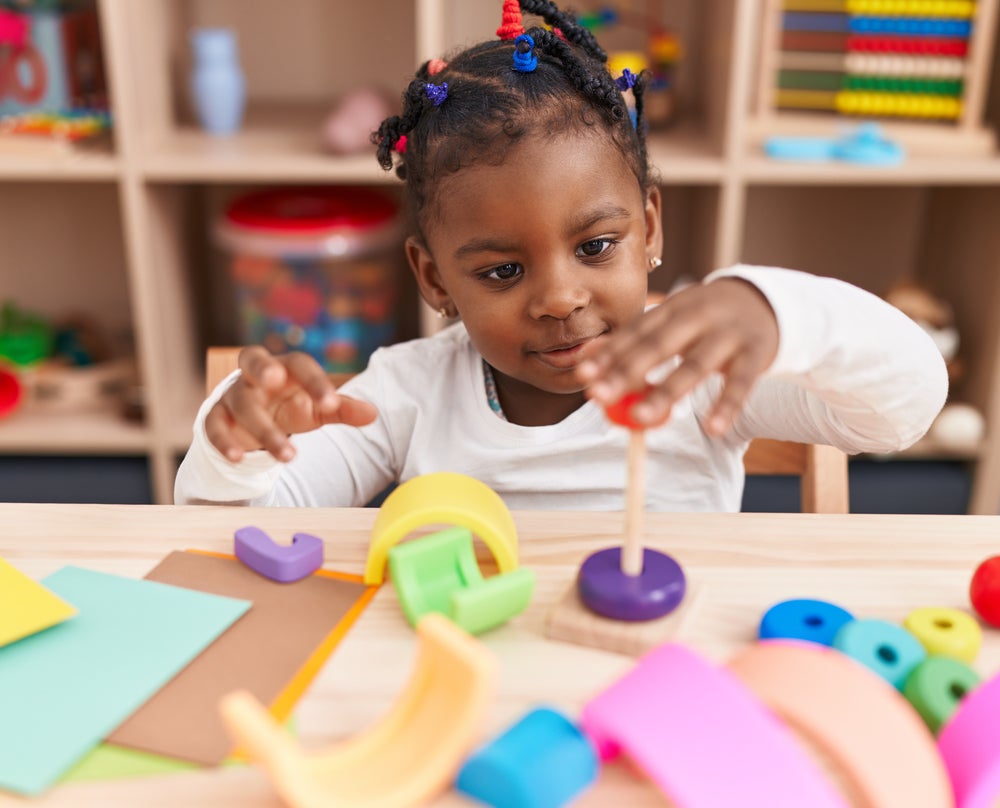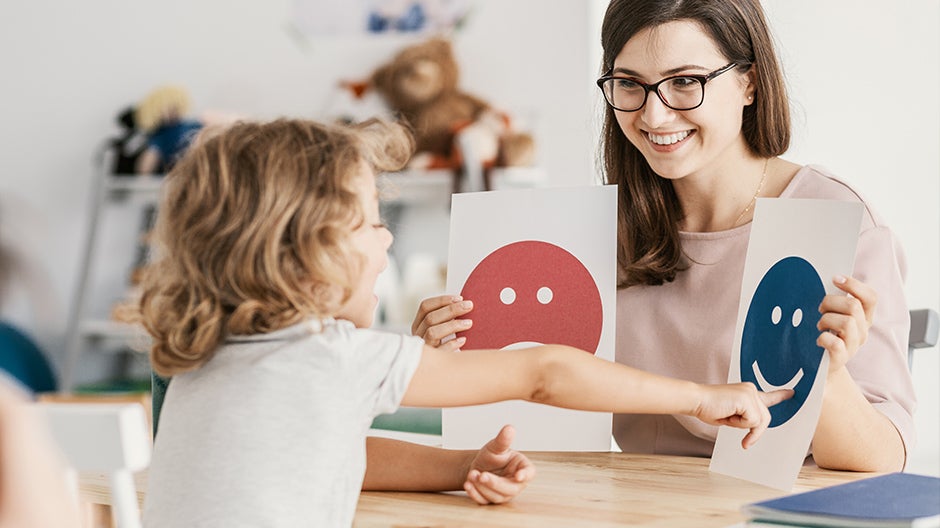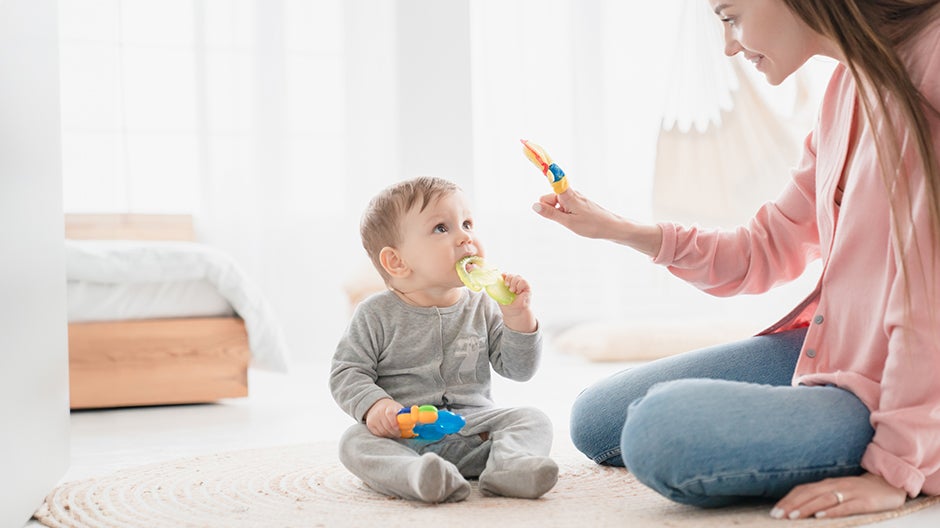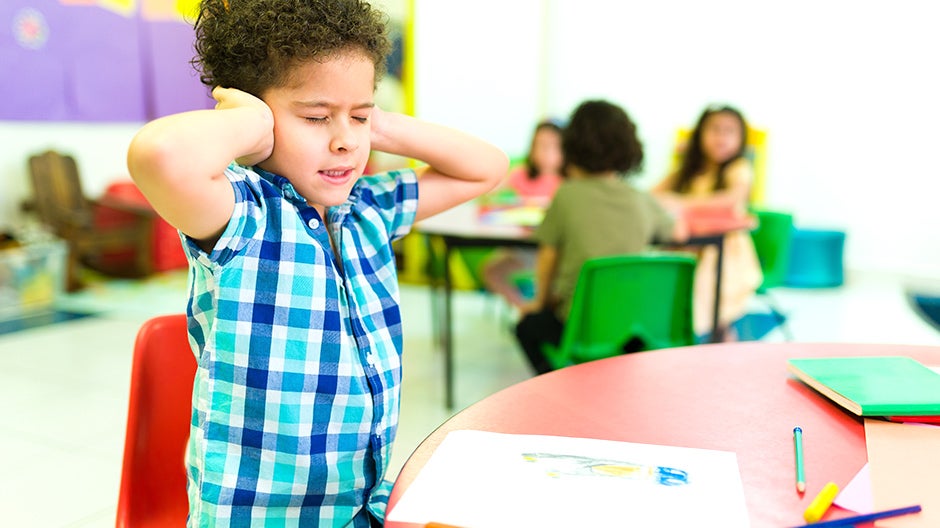Learning shapes isn’t just about teaching your child to draw a circle or square.
For toddlers, preschoolers, and kindergarteners, recognizing shapes is an important Core Skill, one of the 5 C’s at the heart of the Begin Approach to helping kids thrive in school and life.
Shapes fill the world around us. A window is a rectangle, a wheel is a circle, a tortilla chip is a triangle. Learning shapes can take place anywhere, anytime, and it helps kids in math, reading, science, and art!
Looking for activities for learning shapes, and more information about why it matters? We’ve got your back!
The Short Cut
- When kids learn to identify shapes, they also learn to distinguish between objects and categorize things
- Learning shapes can help kids with counting, problem-solving, patterns, and spatial recognition
- Parents can help by pointing out shapes in everyday life, providing toys that use shapes, and playing games that teach shapes with their kids
- A play-based learning membership can help kids recognize shapes and develop the other essential building blocks of learning
30 Innovative Activities for Learning Shapes
1. Shape Books
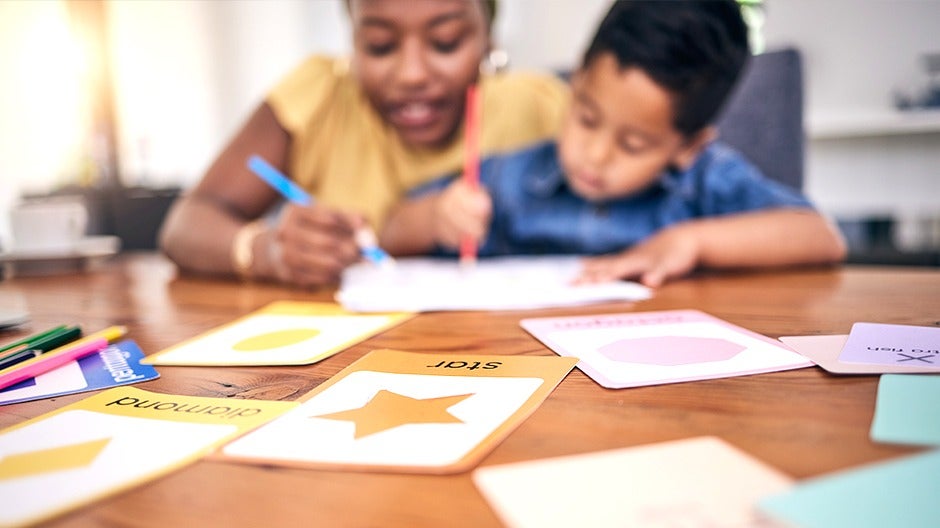
If your child loves reading, this project will be exciting for them. They get to “write” their own book!
What You Need
- Paper (colored and plain)
- Kid-safe scissors
- Stapler
- Markers
What to Do
- Start with a circle book. Help your child cut out 2 circles from colored paper. These will be the front and back covers of the book.
- Cut out a dozen or so circles of the same size. These will be the internal pages.
- Staple the front cover, inside pages, and back cover together.
- Help your child make the cover page by writing This is my book about circles (or something similar).
- Brainstorm objects that are shaped like a circle—wheel, moon, pie, and others.
- Your child can draw one object on each page of the book.
- Help them write the name of the shape under the drawing (or write it for them if they haven’t learned to write yet).
- Make as many different shape books as you want!
2. Shape Sorter
This is like a life-sized puzzle!
What You Need
- Painter’s tape
- Household objects
What to Do
- Create large shape “containers” on the floor with painter’s tape.
- Find objects in your house with different shapes—like a ball, a plate, a block, a book, and so on.
- Ask your child to place objects into the matching shape “containers.” The plate would go inside the circle, and the book would go inside the rectangle.
- For the next round, invite your child to search with you for objects to use!
As your child places the objects inside the “containers,” you can ask some thoughtful questions, like “How do you know that plate goes into the circle shape?” and “Why didn’t you put the book in the triangle?”
You may need to guide them through the answers (“The circle is made of one long curved line. The triangle has three sides.”) to help them learn to describe shapes.
3. Shape Snacks
Do some shape learning and then eat!
What You Need
- Paper
- Pencil/marker
- Food (of a variety of shapes!)
- Cookie cutters
What to Do
- Draw various shapes on a piece of paper.
- Place it in front of your child at the table like a place mat.
- Give your child an assortment of foods that fit into different shape categories. For instance: crackers, slices of cheese, strawberries (if you can find triangular ones), and toast or sandwiches of different shapes (cookie cutters are useful here).
- Ask your child to place the food into the appropriate shape on their place mat before they eat it!
4. Shape Maze
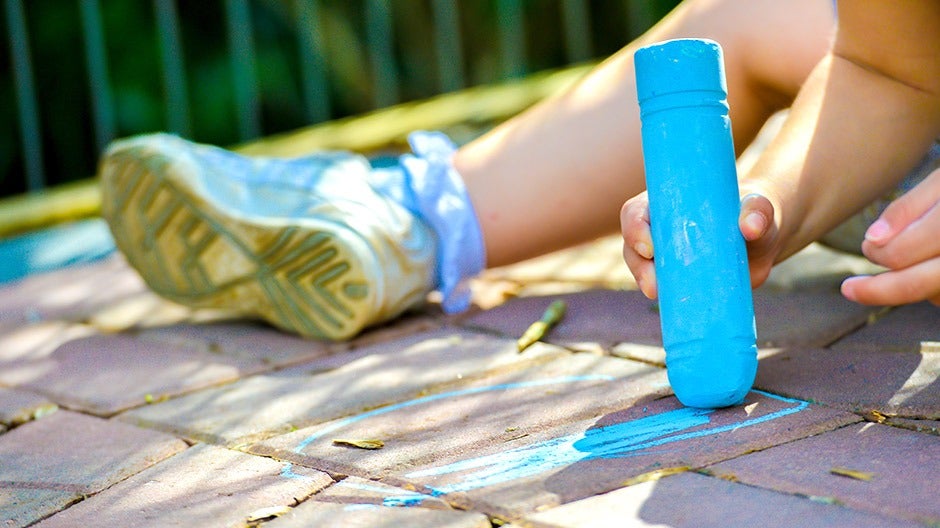
It’s always a great idea to mix up learning by getting your child outside and moving!
What You Need
- Chalk
- Sidewalk, driveway, or park surface
What to Do
- Draw shapes on the ground, big enough for your child to stand in.
- Get creative with your configuration! You can follow a typical hopscotch grid, substituting shapes for boxes. Or you can make a maze that winds around a path.
- Challenge your child to go from one end of the maze to the other by following paths made of different shapes (only stepping on squares, for instance).
- Try this multiple times with each shape.
5. Nature Walk—Shape Edition
Head outside with your child for a shape hunt!
What You Need
- Clipboard, paper, and pencil
- Kid-safe scissors
What to Do
- Take a walk with your child with the intention of searching for shapes together.
- Draw the shapes you see on a piece of paper.
- When you return home, cut out the shapes and try sorting your finds into categories (square, circle, triangle, etc.).
You can also mix up this activity by searching for objects small enough to pick up, like rocks and sticks, and bringing them home to sort.
6. Shape Puzzles
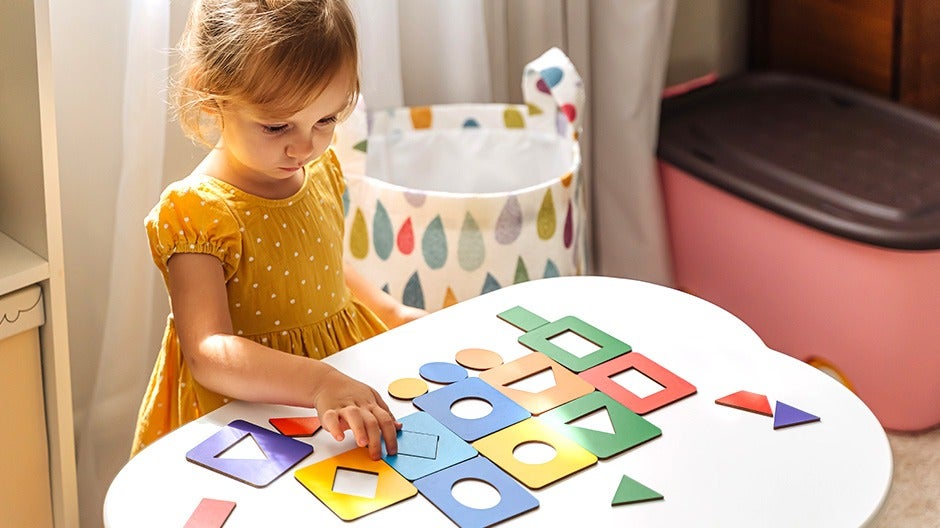
Puzzles provide excellent learning opportunities for kids, helping them develop problem-solving and Critical Thinking as well as shape awareness.
What You Need
- Popsicle sticks
- Markers
What to Do
- Line up 3–4 popsicle sticks into a shape.
- Trace and color in the shape.
- Take the popsicle sticks apart.
- Ask your child to put the shape back together with the sticks.
For a bigger challenge, make a few of these puzzles in different shapes. Put all of the separate pieces into a pile and ask your child to separate them and make each of the puzzles.
7. Hook-and-Loop (Velcro) Shapes
This activity uses popsicle sticks with hook-and-loop dots (think Velcro) to create a fun, adaptable way to make shapes.
What You Need
- Popsicle sticks
- Hook-and-loop sticker dots (like Velcro)
What to Do
- Place a hook-and-loop dot on each side of the end of a popsicle stick.
- Repeat on the other end of the popsicle stick.
- Do this for as many popsicle sticks as you’d like.
- Experiment with connecting the sticks together to make different shapes.
Try drawing a shape on a piece of paper and challenging your child to build it with the sticks!
8. Rainbow Rock Shapes
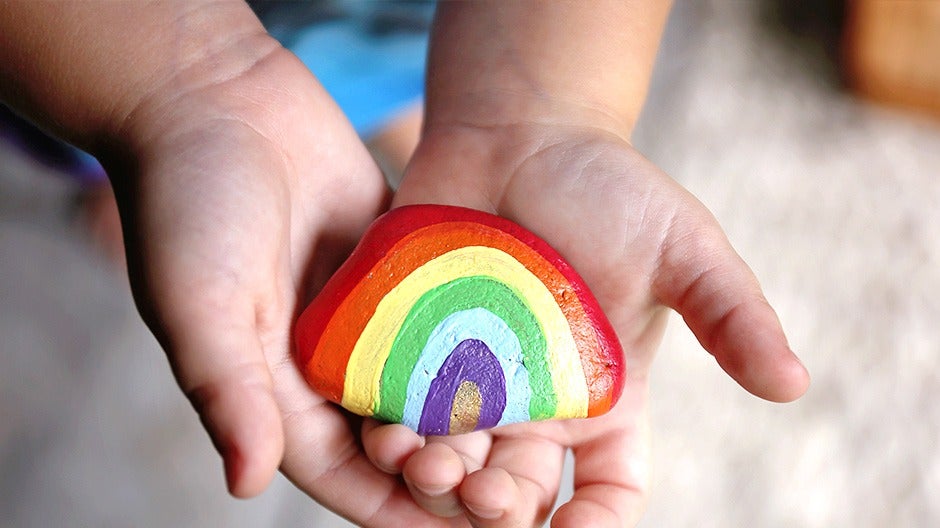
This activity is not only useful for learning about shapes, but it can be adapted into a more general sorting game.
How many rocks have triangles on them? How many are painted yellow? How many are small? And so on.
What You Need
- Rocks
- Kid-safe, nontoxic acrylic paint
- Paintbrush
What to Do
- Collect rocks with your child.
- Paint each rock a different color—one red, one blue, one purple, and so on.
- Let them dry.
- Paint shapes onto the rocks.
9. Sponge Painting with Shapes
Sponge painting is perfect for young kids because the sponges are soft and easy to grip (no need for the fine motor skills required to hold a paintbrush).
What You Need
- Sponges
- Kid-safe scissors
- Kid-safe, nontoxic paint
- Paper plate
- Paper
What to Do
- Cut out shapes from the sponges.
- Place a dab of paint on a paper plate.
- Give your child a piece of paper and the sponges and paint.
- Encourage your child to experiment with pressing the sponges down on the paint, then on the paper to make shapes.
10. Block Painting
Blocks are not only fun to build with—they’re fun to paint with too!
Foam blocks work best here, but you can also use wooden blocks for this art project. This is a great activity to do outside when the weather is warm! Be sure to lay down a protective cloth before you start.
What You Need
- Blocks
- Kid-safe, nontoxic paint
- Paper
- Paper plates
What to Do
- Pour some paint onto a paper plate.
- Lay a piece of paper on a table or the ground.
- Demonstrate to your child how to dip the blocks in the paint and then press them to the paper to make a shape.
Urge your child to experiment. What happens when they press hard on the block? What about when they use the corner of it? How many different prints can they make from one block?
11. Shape Yoga

This is a fun way to get your child moving and teach them about shapes at the same time!
What You Need
- Nothing!
What to Do
- Raise your arms above your head and touch your hands together for a circle.
- Bend over and touch the floor in front of your toes to make a triangle.
- Widen your legs and stretch your arms out on both sides for a star.
- Ask your child if they have any ideas for shapes your bodies can make!
12. Shape Sensations
Add a hands-on element to learning shapes!
What You Need
- Textured materials like sandpaper, cardboard, fabric, and bubble wrapping
- Kid-safe scissors
What to Do
- Cut out an assortment of shapes from the various materials.
- Place them in a bowl or bag.
- Ask your child to explore the shapes with their hands. Can they describe how they feel?
Try cutting out each shape you use from each material at least once so your child can compare the feel of a fabric square to a cardboard square to a bubble wrapping square, and so on.
13. Shape Bingo
Kids have a blast playing this classic game. And they’ll learn about shapes at the same time!
What You Need
- Paper
- Index cards
- Markers
What to Do
- Draw a Bingo grid on a piece of paper, but instead of writing numbers inside the squares, draw shapes.
- Cut an index card into small pieces and draw shapes matching those on the Bingo grid on one side of them.
- Place the index card pieces in a bowl.
- Give your child the Bingo grid.
- Pull shape cards from the bowl. If your child identifies a match, place the card on their grid.
- Once they have a whole row filled, they win!
14. Play Dough Tracing
This one is great for younger kids. After your child fills in the shape they make with play dough, they can remove it from the outline and save it!
What You Need
- Several sheets of paper
- A marker
- Play dough of different colors
What to Do
- Draw several versions of the same shape at different sizes on a single sheet of paper. Use thick, bold lines so your child can clearly see the perimeter of each shape.
- Ask your child to use different colors of play dough to fill each shape outline.
If your child is familiar with shapes already and you want to make this more advanced, you can draw several different shapes on one piece of paper.
15. Shape Scavenger Hunt
You and your child can go for a walk in the neighborhood or hunt for shapes inside the house on a rainy day.
What You Need
- A piece of paper with basic shapes on it
- A marker
What to Do
- Snoop around outside or in the house like sneaky shape detectives, using your “cheat sheet” of shapes to keep a tally of how many times you can find each shape.
- Help your child recognize the ways shapes naturally occur in everyday life—mirrors can be rectangles or circles, pizza slices are like triangles, and so on.
Keeping track of what your child can find will give both them and you some insight. They’ll start to see how many shapes are all around them, and you may notice which shapes your child is already good at recognizing, and which they need a little more help identifying.
16. Shape Pizza
You and your child will be opening your own pizzeria! The “secret ingredient” to your delicious pizza? Shapes!
What You Need
- Colored construction paper (red, yellow, green, brown, black, and white)
- Kid-safe scissors
- A single die
What to Do
- To make a pizza, cut out a large circle for your “crust.”
- Cut out shapes to represent a variety of ingredients. Depending on what your child likes to eat, you can adjust the ingredients and shapes (circles for pepperoni, triangles for cheese, rectangles for peppers, squares for mushrooms, semicircles for olives)
- Make a menu with the shapes and what they stand for.
- Place an order for which topping you want and have your child roll the die to see how many of that topping the pizza will have. (If your child is still learning numbers, you can start with one of the topping to make the activity easier).
- Have your child put the shapes on the pizza and serve it to you. (Kids often want you to pretend to eat it too!)
We recommend referring to the shape names as you order and again when “checking” the order. You could say, “That’s it! I get four circle pepperonis. Yum!” You can then switch roles and let your child order a pizza.
To play with older children or make the game a bit more challenging, order a pizza with more than one topping, with your child rolling the die once for each topping to determine how many you get.
Once you’re finished with a pizza, you can glue the shapes to the paper to save as a keepsake or remove them and make another pizza!
17. DIY Shape Sorter
A homemade variation on the classic toy!
What You Need
- Blocks of various shapes
- Container with a large lid
- Ballpoint pen
- Scissors or a sharp knife (for adult use only)
- Piece of construction paper (optional)
- Glue (optional)
What to Do
- Lay the blocks on the lid and trace each shape with the pen. Press down hard enough to leave an outline of each shape.
- Using scissors or a knife, carefully cut each shape out yourself.
- If you want to decorate the container, wrap it with a piece of construction paper and glue it in place.
- Put the lid back on the container.
- See if your child can find the right openings for each block!
18. Shape Scapes
Combine math and art into a fun activity that helps your child recognize and compare shapes.
What You Need
- Piece of cardboard or paper for the base
- Various found shape objects, such as paper towel tubes, balls, blocks, and cereal boxes (objects should be larger than the opening of a paper towel tube)
- Tape
- Glue
What to Do
- Place all of the found shape objects in front of your child.
- Help your child arrange the objects on the base to create a landscape. For instance, a paper towel tube can be a tree and a cereal box can be a house.
- Discuss the shapes you’re using as you go (“This box looks like a rectangle. That kind of looks like a house.”).
- Tape and glue the objects to the base.
19. Shape Treasure Map
Who doesn’t like to be a detective? Give your child the task of finding hidden shapes. Draw the map and hide the treasures ahead of time, so your child can jump right into the creative play!
What You Need
- Paper
- Markers
- Objects to use as treasure
What to Do
- Hide objects in a designated space. (The space can be a room in your home, your entire home, or a place outside.)
- Draw a map of the space.
- Add shape “landmarks” (places where you’ve hidden the shapes that correspond) onto the map. For instance, if you hide a square block behind a tree, you would draw a square on the map near a tree.
- Give your child the map and ask them to bring all of the treasure back to you!
20. Shape Story Time
Add some math into story time by reading books that feature shapes!
What You Need
- Books
What to Do
- Read!
Some great books to use include:
My Very First Book of Shapes by Eric Carle
Mail Duck by Erika Sirotich
Circle, Triangle, Elephant by Kenji Oikawa and Mayuko Takeuchi
Round Is a Tortilla by Roseanne Thong and John Parra
Crescent Moons and Pointed Minarets by Hena Kahn and Mehrdokht Amini
Triangle by Mac Barnett and Jon Klassen
City Shapes by Diana Murray and Bryan Collier
21. Make Cookies
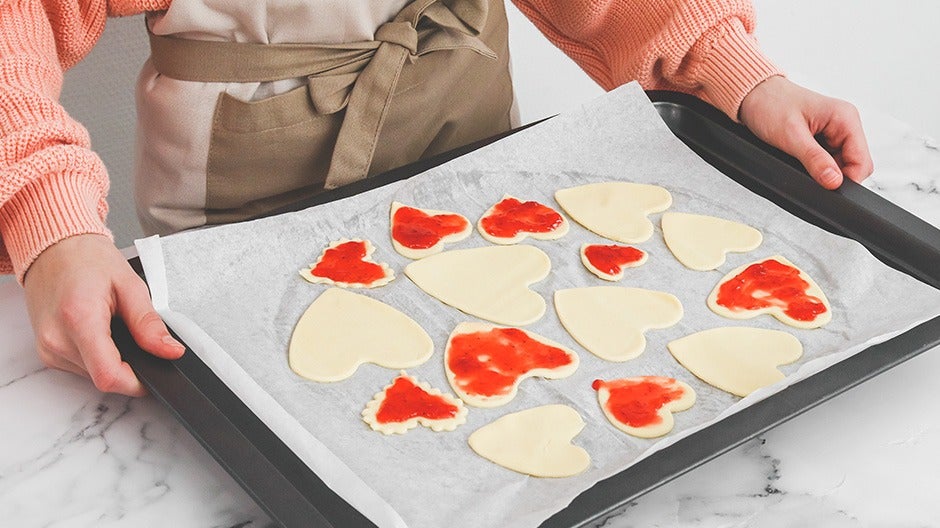
A delicious way to study shapes! You can expand on the activity by challenging your child: “How can you make the same shape without the cookie cutter? Can you make it bigger? Smaller? What happens if you combine a few of the shapes?”
What You Need
- Cookie dough
- Cookie cutters
- Rolling pin
- Baking tray
What to Do
- Make or buy cookie dough (sugar or gingerbread cookie dough works best).
- Roll out the dough onto a floured surface.
- Use the cookie cutters to cut the dough into shapes.
- Place the shapes on the baking tray.
- Bake according to your recipe (use the recipe on the packaging if you bought your dough).
- Eat!
As you work and eat, discuss the names of the shapes you’re making with your child. This one can be a lot of fun!
22. Shape Collage Art
Making collages is a hands-on art project that can get your child imagining real-world objects and translating them into combinations of shapes.
What You Need
- Colored paper
- Glue
- Kid-safe scissors
What to Do
- Cut shapes out of the colored paper. Vary their size and color. If your child is able to use scissors, they can help with this part.
- Give your child a whole piece of paper to use as the base.
- Show them how to glue the shapes onto the base to make scenes. (For example, make a car using circles for wheels and rectangles for the body, then make a road for the car out of rectangles or squares.)
23. Giant Shape Art
This art activity teaches your child about shapes while making a really beautiful mural!
What You Need
- A big piece of cardboard (like from a box)
- Kid-safe nontoxic paint
- Painter’s tape
- Paintbrushes
What to Do
- Flatten the box to give you a thick “canvas” to paint on.
- Using the painter’s tape, mark out painting sections in different shapes. Wherever the tape is, the paint won’t stick.
- Let your child paint inside the tape lines.
- Talk to them about what they’re doing using the shape names as they go. (“Oh, you’re going to paint blue inside that triangle? Looks good!”)
- Peel the tape off when they’re finished to see the final design!
24. Pipe Cleaner Shapes
Your child can build their fine motor skills as they learn about shapes with this activity.
What You Need
- Pipe cleaners
What to Do
- Help your child bend the pipe cleaners into different shapes.
- To make bigger shapes, help them twist two (or more!) pipe cleaners together.
- Talk about what you’re making as you make the shapes.
To keep and display your shapes, glue the pipe cleaners to a piece of paper.
25. Shape Sorting Suncatchers
This one’s for a sunny day! Making sun catchers gives your child some shape learning time and helps develop fine motor skills too.
What You Need
- Pieces of thick paper (like card stock)
- Contact paper
- Shapes made out of foam, plastic, or other lightweight materials
What to Do
- Cut large frames of different shapes out of the thick paper.
- Place the frames on the contact paper and trace the inside perimeter of each on the contact paper.
- Cut out the contact paper, following the lines you traced. Leave a little extra on all sides.
- Stick the contact paper onto the frames.
- Hang the sun catchers in a window, sticky side out, making sure your child can reach them.
- Gather the shape objects into a basket.
- Your child can now stick shapes onto the suncatcher and pull them back off—over and over again. Make a game of it by asking them to put certain shapes on or off!
26. Shape Roads
Help your child build roads as they build their shape-identifying skills!
What You Need
- Pieces of thick paper or thin cardboard
- Kid-safe scissors
- Markers
- Play cars
What to Do
- Cut out shapes from the thick paper or cardboard. These will be your roads.
- Add “road” details like yellow lines to the shapes.
- Your child can lay out the roads on the floor and drive their cars over them.
As your child builds, talk about the shapes they’re using to help them learn.
27. Move with a Ball
When you need your kid to move on a rainy day, this is your game!
What You Need
- Painter’s tape
- Indoor ball
What to Do
- Find an open space in your home (even a hallway works great for this).
- Make a maze of large shapes on the floor with the painter’s tape.
- Sit on one side of the shape maze and have your child sit on the other side.
- Roll the ball to your child, naming the shapes it moves across as it rolls.
- Have your child do the same.
You can create all sorts of variations on this game! Try bouncing the ball. Ask your child to dribble it across the maze. Use bean bags. Or your child may want to hop, jump, or run across the shapes!
28. Feed the Monsters
This game gives your child a chance to practice sorting by shape.
What You Need
- Cardboard
- Kid-safe, nontoxic paint
- Glue
- Kid-safe scissors
- Googly eyes (or markers to draw them)
What to Do
- Cut out large shapes from the cardboard. (Try beginning with one triangle, square, and circle.)
- Paint the shapes.
- Once the shapes are dry, cut mouths out of them, making the shape of the mouth the same as the shape itself.
- Add googly eyes to the monster or draw eyes on it.
- Cut smaller shapes out of the remaining cardboard. (You can paint it first or leave it plain.) They can be various sizes as long as they fit into the mouths of the monsters.
- Mix up the small “food” shapes and put them into a bowl.
- Stand up the monsters against the wall.
- Ask your child to feed the monsters, making sure the shapes of the food match the shapes of the monsters!
29. Spaghetti Shapes
An activity that encourages playing with food!
What You Need
- Spaghetti noodles
- Olive oil
- Plastic bin or bowl
- Paper
- Markers
What to Do
- Cook the spaghetti noodles according to the instructions on their packaging.
- While the noodles are cooking, draw one large shape on each piece of paper.
- When the noodles are done, rinse them with cold water and toss them with a little olive oil.
- Your child can now grab individual noodles and lay them over the outlines of the shapes on the paper.
Hopefully your child will have fun with this activity for as long as it takes you to make dinner!
30. Outside Shapes
Your child will have to use some Critical Thinking skills and Creativity as they do this activity.
What You Need
- A basket
- An outside space to explore
What to Do
- Tell your child you’re going on a hunt outside to find as many objects as will fit into their basket.
- As you explore (your yard, the park, or any other outside space), urge your child to gather all kinds of objects, like rocks, blades of grass, leaves, sticks, and more!
- Once they’ve stuffed their basket, find a place to sit and help your child examine what they’ve found. What are they? What colors are they? Are some small? Some large? Are they hard? Soft?
- Challenge your child to make shapes using the objects. If they get stuck, help them by asking some leading questions. Can they make a circle out of the rocks? What objects would be best for making a square?
- See how many variations they can come up with!
Use HOMER for Shape Learning
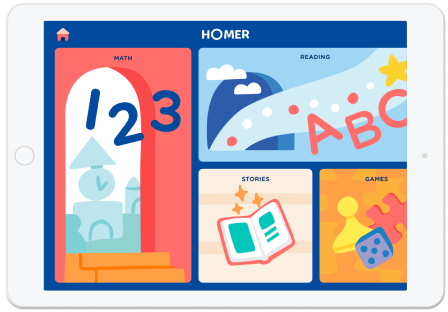
If you want to incorporate effective, personalized digital learning into your daily activities, our award-winning HOMER app will help your kids with shape learning and other Core Skills like reading, writing, and math.
It has tons of shape activities for your child, like Castle Creator and Pizza Parlor, where they’ll make pizzas for customers who pick exactly how many toppings they want.
Why Learning Shapes Matters
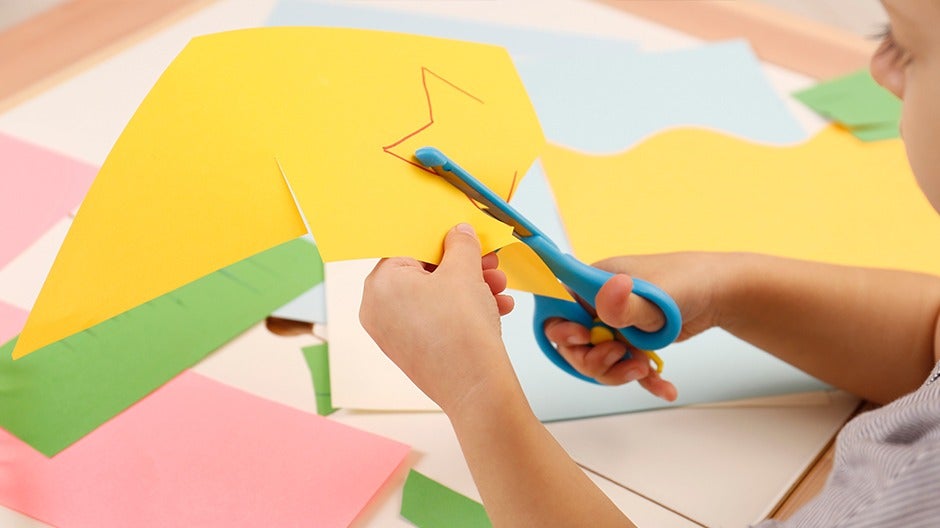
Shapes are all around us. If you glance around the room you’re in, you can probably identify a handful of shapes within seconds.
For a preschooler, learning shapes provides an early step to understanding how numbers and objects relate to one another. It will especially help them with pre-K math as they count the number of sides on a single shape, applying counting skills to an object.
But that’s not all shapes are good for! Learning shapes also helps kids get a grasp on the following important skills:
1. Distinguishing between Objects
Learning shapes helps your child learn to differentiate between objects (“This block has four sides. This block has six sides.”).
As kids explore how shapes are different from one another, they’ll pay attention to the little details of each shape. This ability to focus on details, identify differences, and categorize things helps them learn no matter what skill they’re tackling.
2. Spatial Reasoning and Problem-Solving
You’ve probably seen shape puzzles. Their pieces are basic shapes that kids can pull out from a base, leaving a blank space where the child fits the shape back in later.
They’re popular for a reason. The blanks inside the puzzle develop your child’s spatial reasoning and problem-solving skills, as they have to try multiple shapes until they find the right one to fit each space.
Learning about shapes through this kind of hands-on play helps develop Critical Thinking.
3. Categorization
Categorizing objects is an important early Core Skill because it lays the foundation for more complex math abilities later.
In math, kids will learn to categorize numbers into sets and subsets (think even and odd numbers, numbers greater than 10, even numbers containing a 2, etc.). A child who can sort objects based on their shape (or their color and size) will have a head start in understanding how to do this.
4. Counting and Patterns
Shapes help your child learn how to count because many shapes are identified by the number of sides they have.
But shapes can also help kids learn how to form patterns! As your child gets more comfortable with shapes, you may find they start making patterns with shape-based toys like magnetic tiles or blocks (red square, blue square, green square, red square, blue square, green square).
You can also demonstrate this to them when you play or draw together.
Pattern recognition matters for kids (and adults!) because people often look for patterns to make sense of the world. Detecting patterns can help us understand how and why something works the way it does.
For children, patterns are also related to the comfort they find in daily routines. For instance, a bedtime routine that always follows the same steps (brushing teeth, reading a story together, hugs, then lights out, and repeat it all over again tomorrow and the next night and the next night) is a kind of pattern.
Your child’s life will be full of patterns, and playing with patterns using shapes can help them get comfortable recognizing patterns and creating their own.
5. Early Literacy Skills
Learning to identify shapes is a step toward gaining early literacy skills too. The letter “A” looks like a triangle. The letter “O” looks like a circle. Knowing those shapes provides a shortcut to learning the letters.
Shapes in Daily Learning: 5 Tips for Parents and Educators
Recognizing shapes in two dimensions—circles drawn on paper, squares on a whiteboard, triangles in a book—is only the tip of the shape-learning iceberg.
A critical next step is helping your child see shapes all around them. This is a simple and fun endeavor, and it makes a huge difference. Once they can recognize shapes in the sizes, contexts, and colors of the world, they’ll be on their way to really grasping the concept of shape.
What are some of the best ways to incorporate shape learning into your everyday life? Try these five:
1. Embrace Spontaneity and Fun
Learning is much more likely to happen if it’s fun! Take advantage of extra time and play some shape games!
If you’re stuck in a grocery store check-out line, ask your child to find (and name) as many circles as they can see. If you’re waiting in the dentist’s office, play I Spy: Shape Version and take turns guessing shapes in the room.
2. Encourage Shape-Making
Don’t just talk about shapes, urge your child to create them!
This can be a spontaneous activity. If your child is playing with blocks, ask them to build a rectangle. If they’re digging in the sand at the beach or the playground, challenge them to make a circular castle.
Hands-on learning often solidifies skill-building.
3. Extend the Conversation
As you look for shapes and encourage your child to build them, expand the shape-learning lesson to include organizational management and categorization.
So while you’re in that grocery line, ask your child to name the shape of the candy bar in the display. Then ask: “How many other candy bars are the same shape? Why do you think they’re all the same?”
And while you’re building with blocks, challenge your child to build a small rectangular tower, then a medium one, and then the tallest one they can.
4. Add Some Analysis
According to the organization DREME (Development and Research in Early Mathematics Education) at Stanford University, kids need to learn to “analyze shapes, identify their defining properties and talk about them.”
You can help with this!
Your child will build a better mathematical foundation the more they interact with all aspects of shapes.
For instance, when you ask your child to find a circle while you’re on a walk and they point out a railroad crossing sign, ask them: “How do you know it’s a circle?” Later in your walk you might point out a ball on the playground and ask: “What shape is this ball?”
Giving your child the opportunity to wrap their head around how those two objects are similar (as well as what makes them different) strengthens their problem-solving and Critical Thinking skills as they relate to shapes and mathematics in general.
5. Adapt the Lessons
These basic ideas can grow as your child gains skills. You can introduce more complex shapes, such as diamonds, hexagons, and trapezoids. You can also challenge your child to categorize more deeply—maybe by color, size, distance from where you are, and material.
You know the kinds of activities your child likes best. If they prefer a hands-on approach, maybe ditch the grocery store activity (candy bars will be too tempting!) and hone in on the blocks or the beach. If your child is really into art, bring some shells home from the beach and paint different shapes onto them. The variations are endless.
4 Ways to Encourage Deeper Shape Exploration
Once your child is identifying shapes, they’re ready to dive deeper and lay the groundwork for understanding more complicated mathematical concepts, like geometry.
Here are some ways to help them:
1. Create and Take Apart Shapes
- Create new shapes, like gluing two triangles together to form a rectangle.
- Deconstruct shapes, like cutting apart a cereal box into its separate rectangles (top, bottom, and four sides) and then putting it back together.
- Put together a complex shape puzzle.
2. Try Spatial Visualization
- Make art or do puzzles with tangrams, polygons that can be put together to form different shapes.
- Play transformation games, like asking your child to take their stuffed animal and flip it upside down or turn it on its side. These terms become important in geometry.
- Once your child builds something with blocks, place a mirror in front of their design so they can begin to understand the idea of a flipped image.
3. Use Geometry Vocabulary
Geometry can sometimes feel like a foreign language! If you can find a way to incorporate some geometry-specific language into your conversations, you’ll give your child a leg up on it when they encounter it in school. Use words like:
- Point
- Line
- Plane
- Angle
- Polygon
4. Find Geometry in the Real World
Geometry shows up in real life all the time. Help your child see that shapes don’t exist only in games and activities (or at school)! They figure heavily in a number of professions, including:
- Architecture
- Art
- Sports
- Mapping
- Graphic Design
Shape Learning with Begin
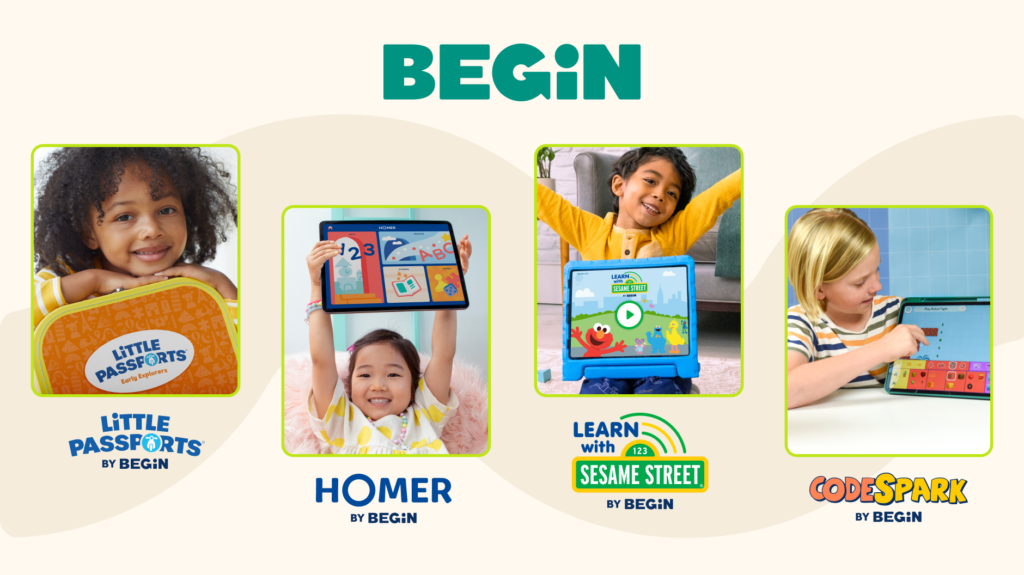
Adding shape-learning activities to your time with your child lets you teach them an important skill while having fun. Whether you use them while waiting or walking or playing together, it’s time well spent.
You can find even more chances for your kids to learn about shapes (and build other essential skills) with our age- and stage-matched learning membership!
We can support your child’s budding understanding of mathematical concepts wherever they are in their journey with engaging, research-backed hands-on and digital activities.
Take our online quiz today to discover which stage of our membership is best for your family!
